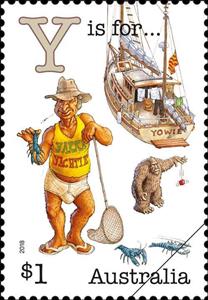Stamp: Y is for... (Australia 2018)
Y is for... (Australia 2018)
18 September (Australia ) within release Fair Dinkum Aussie Alphabet Part 4 goes into circulation Stamp Y is for... face value 1 Australian dollar
| Stamp Y is for... in catalogues | |
|---|---|
| Colnect codes: | Col: AU 2018-24D |
Stamp is square format.
Also in the issue Fair Dinkum Aussie Alphabet Part 4:
- Stamp - O is for... face value 1;
- Stamp - Y is for... face value 1;
- Stamp - Z is For... face value 1;
- Stamp - Y is For... face value 1;
- Stamp - X is For... face value 1;
- Stamp - E is For... face value 1;
- Stamp - E is for... face value 1;
- Stamp - O is For... face value 1;
- Stamp - Z is for... face value 1;
- Stamp - X is for... face value 1;
- Booklet - E is For... face value 10*1;
- Booklet - O is For... face value 10*1;
- Booklet - X is For... face value 10*1;
- Booklet - Y is For... face value 10*1;
- Booklet - Z is For... face value 10*1;
|
Data entry completed
46%
|
|
|---|---|
| Stamp Y is for... in digits | |
| Country: | Australia |
| Date: | 2018-09-18 |
| Emission: | Commemorative |
| Format: | Stamp |
| Face Value: | 1 Australian dollar |
Stamp Y is for... it reflects the thematic directions:
Animals are multicellular, eukaryotic organisms of the kingdom Animalia (also called Metazoa). All animals are motile, meaning they can move spontaneously and independently, at some point in their lives. Their body plan eventually becomes fixed as they develop, although some undergo a process of metamorphosis later on in their lives. All animals are heterotrophs: they must ingest other organisms or their products for sustenance.
A modern sailing ship or sailship is any large wind-powered vessel. Traditionally a sailing ship (or simply ship) is a sailing vessel that carries three or more masts with square sails on each. Large sailing vessels that are not ship-rigged may be more precisely referred to by their sail rig, such as schooner, barque (also spelled "bark"), brig, barkentine, brigantine or sloop. There are many different types of sailing ships, but they all have certain basic things in common. Every sailing ship has a hull, rigging and at least one mast to hold up the sails that use the wind to power the ship. The crew who sail a ship are called sailors or hands. They take turns to take the watch, the active managers of the ship and her performance for a period. Watches are traditionally four hours long. Some sailing ships use traditional ship's bells to tell the time and regulate the watch system, with the bell being rung once for every half hour into the watch and rung eight times at watch end (a four-hour watch). Ocean journeys by sailing ship can take many months, and a common hazard is becoming becalmed because of lack of wind, or being blown off course by severe storms or winds that do not allow progress in the desired direction. A severe storm could lead to shipwreck, and the loss of all hands. Sailing ships are limited in their maximum size compared to ships with heat engines, so economies of scale are also limited. The heaviest sailing ships (limited to those vessels for which sails were the primary means of propulsion) never exceeded 14,000 tons displacement. Sailing ships are therefore also very limited in the supply capacity of their holds, so they have to plan long voyages carefully to include many stops to take on provisions and, in the days before watermakers, fresh water.
Marine life, or sea life or ocean life, refers to the plants, animals and other organisms that live in the salt water of the sea or ocean, or the brackish water of coastal estuaries. At a fundamental level, marine life helps determine the very nature of our planet. Marine organisms produce much of the oxygen we breathe. Shorelines are in part shaped and protected by marine life, and some marine organisms even help create new land. Altogether there are 230,000 documented marine species, including over 16,000 species of fish, and it has been estimated that nearly two million marine species are yet to be documented. Marine species range in size from the microscopic, including plankton and phytoplankton which can be as small as 0.02 micrometres, to huge cetaceans (whales, dolphins and porpoises) which in the case of the blue whale reach up to 33 metres (109 feet) in length, being the largest known animal.



